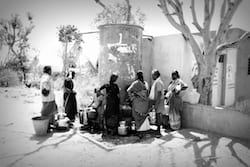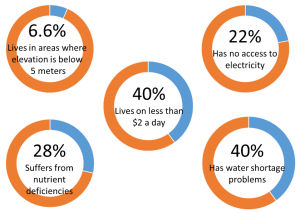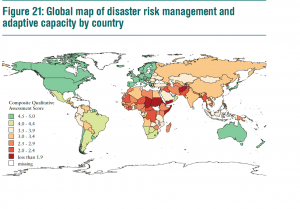Climate Change and Resources
By ucqbaza, on 6 March 2014
Blog by Alex Zardis, Student at the Bartlett School of Graudate Studies
Climate Week means different things for different people, it may mean the promotion and campaigning of a sustainable and low-impact lifestyle to influence the next generation, for myself, I see it as a chance to reflect on our individual behaviour and to look at our personal resource use and attitude. Many different parties are rallying and legislating towards the use of renewable energies and the sustainable use and recycling of materials/products. This is absolutely essential for our societal evolution and these efforts are the first steps forward in an enormous path towards sustainable living, but these steps alone without a major catalyst will not see the major structural change that is needed, not least in our lifetimes. My previous thermodynamics lecturer in Cardiff believed that we will still be using coal and oil as a main source of fuel at the end of our lifetimes, if this would be true it brings a realisation our society has built its infrastructure so dependent on these fuels and related technologies. Individually, to increase the efficiency of our resource use we have a very strong alternative to make a significant impact. We can contribute on a personal scale and little by little, a lot is changed.
Cautious resource use does not strictly have to relate to combating climate change and is generally good practice. As a generation whose elders were taught to use resources carefully and wisely under strict military rationing, these practices have sometimes passed down and arrived to ourselves, under the wise words of our grandmothers ‘never to waste a penny’, or rather dubiously perhaps never to waste a really old, out of date can of baked beans or whatever may reside far too long in their cupboards! However we are all guilty of falling short to expectations of sustainable resource use. Despite good intentions and a positive attitude to resource use, sometimes we fall guilty to convenience and to laziness. Maybe it’s just too far to keep take that can or plastic bottle to find the next recycling bin rather than the close waste bin, maybe the appeal of a brand new iphone or computer rather than replacing a screen or battery is appealing. Possibly a now un-used but perfectly fine item lays dormant while the chance for it to be passed on, sold or re-used is wasted. We can use this opportunity of climate week as a chance to make more of an effort in our lives to re-use items and utilise the entire life-cycle potential of our products.
Local councils and the government already provide the services for us to recycle a great range of products, however we should be increasing our use of these facilities. An entertaining and ‘easy to digest’ set of promotional video shorts have been created by the government to explain the actual process that our products go through whilst they are recycled, these are available to view at this website and highly advised to watch! www.recyclenow.com/how_is_it_recycled
These facilities can help discourage the dumping of waste via landfill and to reduce electrical waste and its illegal exportation. Most electrical products are covered under an EU legislation called the WEEE waste electrical and electronic equipment legislation, if you look on any electricity using product within your vicinity, it is likely that it will be covered by this legislation and have a crossed out wheelie waste bin WEEE logo displayed. This legislation and logo display means that the companies involved in its retail and distribution are obliged by law to cover the costs for the product’s safe return and recycling. Whilst this option is provided it is not particularly well known or advertised, hence it is now our turn to be more pro-active about the use of these services.
From another perspective our resources can have their lives extended by re-use rather than re-cycling. Only recently a great local example has been demonstrated and pursued. Reclaimed material leftover from the 2012 Olympic Games was sourced to create a community skatepark in Hackney Wick, East London. This story was supported by Google and told as a commercial. The story video can be seen here: http://www.youtube.com/watch?v=GvgqDSnpRQM. Since its inception it has seen its lease extended by a year, offering local skateboarding, bmx and rollerblading enthusiasts another season of riding.
Concerning the overall perspective of resource use within our society, we are in an age where we are viewing sustainability and the resourceful use of our belongings with increasing positivity. Although despite this It is saddening that behind the individual perspective that this blog entry covers, major entities, companies, corporations and governments still consume far more than they need, and end up with left over waste that is disregarded. UCL does have incentives and is aware of their responsibility to be a sustainable business. However, as could be the case in this day and age, sustainability may be a buzz word within an organisation’s brief, so let’s take a look at a small selection of the realised actions and that are being taken by UCL in conjunction with Green UCL:
- An environmental awareness moodle course/module available at: https://www.ucl.ac.uk/greenucl/resources/awareness_and_good_practice
- A community ‘Green map’ of the UCL campus showing sustainability related local amenities: http://www.communitymaps.org.uk/version6_1/includes/MiniSite.php?minisitename=UCL%20Green%20Map&minisite_group
- An ‘urban cycle skills training’ course and general cycling advice offered by the university in conjunction with Camden Council. (https://www.ucl.ac.uk/greenucl/whats-happening/programmes/cycle_skills_training)
- -Waste and recycling on campus information, carbon management plans and more: http://www.ucl.ac.uk/greenucl/resources
These concern campus wide initiatives, though within UCL individual departments are encouraged to develop their own sustainability strategies. An example of this can be the archaeology department which has listed their incentives and objectives: www.ucl.ac.uk/archaeology/about/facilities/green. My department, the Bartlett School of Graduate Studies, has their own incentives too and we are an environmentally conscious department. There is however always room for improvement and a closer monitoring of the air conditioning of un-occupied rooms within the campus could be pursued, as well as the provision of more cycle parking.
I shall round up my talk concerning sustainability and resources, I hope that this blog has been entertaining and possibly educational! I understand that I have approached this from the perspective of a local London citizen and have not widened the scope of the report to focus on the global issue. I would like to think that in this case the small differences can be achieved individually and create a direct impact on our lives whilst contributing to the greater cause of sustainable resource use, which needs our combined support as a global movement. I hope that during this climate week of 2014, myself and the audience of UCL can make a positive change towards sustainable resource use.
 Close
Close






